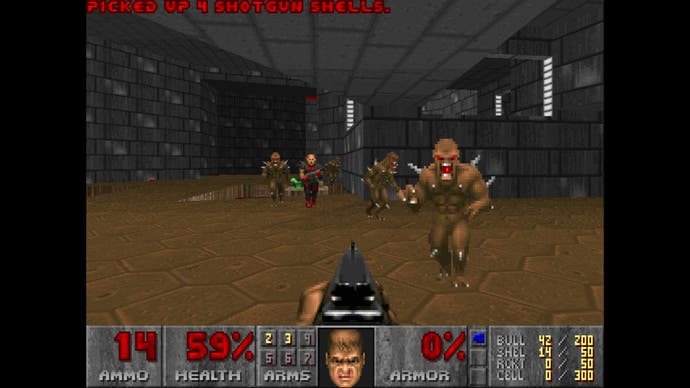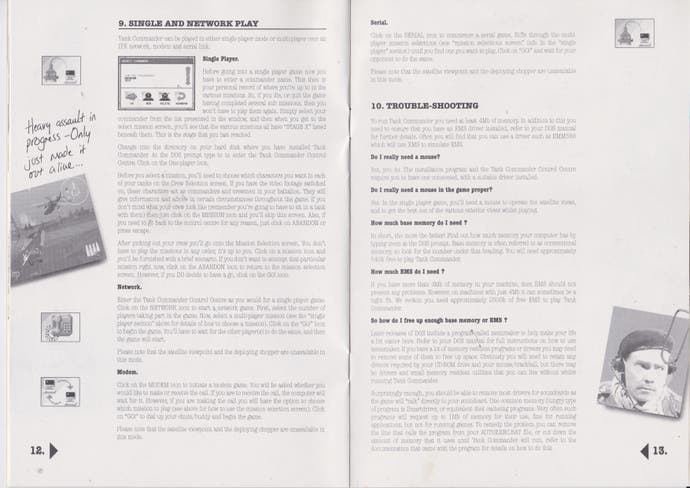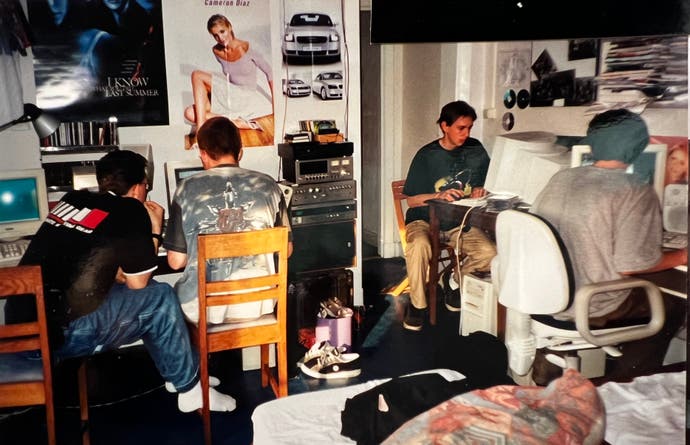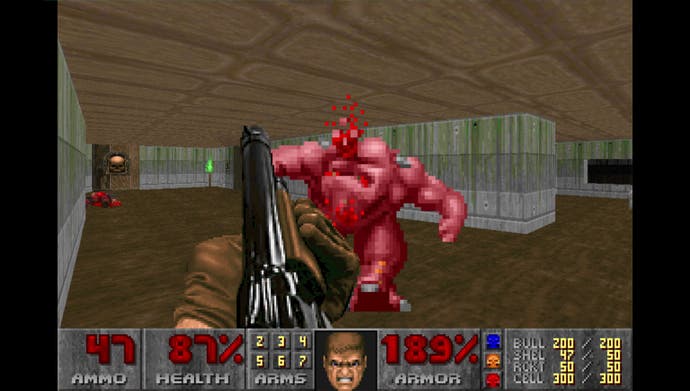صبح شنبه گرمی در تابستان ۱۹۹۴ بود. من در Big Red Software کار میکردم، یک توسعهدهنده بازیهای ویدیویی که در آن زمان در ساوتام، وارویکشر مستقر بود، درست در بالای جاده Codemasters. طبیعتاً ما قبلاً Doom را بازی کرده بودیم که چند ماه قبل منتشر شده بود و هنوز داغ ترین بازی جهان بود. برنامه نویس ما فرد ویلیامز یک نسخه از نسخه اشتراک افزار را در فروشگاه بازی در خیابان لیمینگتون خریداری کرد – می توانستید آن را به صورت رایگان دانلود کنید، اما در آن زمان اینترنت بسیار کند و فوق العاده گران بود، برخلاف بازی که راحت و فوق العاده گران بود. در واقع یکی از هوشمندانهترین تصمیمهای تجاری جان رومرو این بود که به شرکتهای نرمافزاری با کانالهای خردهفروشی از قبل تاسیس شده اجازه داد تا Shareware Doom را بدون هیچ هزینهای از Id Software بفروشند. در زمانی که “ویروسی شدن” هنوز به معنای ابتلا به آبله مرغان در جشن تولد همسرتان بود، این بازی به ویروسی شدن اجازه داد. از آنجایی که روی دیسک محافظت از کپی وجود نداشت، تقریباً به محض اینکه فرد آن را به دفتر آورد، روی رایانههای همه قرار گرفت. ما گیر افتاده بودیم.
اما بعد از چند هفته بازی هنوز یک چیز وجود داشت که امتحان نکرده بودیم – چند نفره. Doom با حالتی راه اندازی شد که اکنون یک حالت آنلاین بسیار ابتدایی در نظر گرفته می شود. این برنامه از پخش همتا به همتا از طریق مودم های شماره گیری پشتیبانی می کند یا می توانید تا چهار بازیکن را از طریق یک شبکه محلی پیوند دهید. ما به عنوان یک توسعه دهنده بازی یکی از آن ها را داشتیم. پس این کاری است که ما آن روز صبح شنبه انجام دادیم. ما وارد کار شدیم تا رایانه های شخصی خود را از طریق LAN اداری وصل کنیم و برای اولین بار با یکدیگر بازی کنیم.
ساعت ده صبح به آنجا رسیدیم و برای چند ساعت بازی برنامه ریزی کردیم. اگرچه در آن زمان هیچ سیستم خواستگاری یا لابی وجود نداشت، راه اندازی آن چندان سخت نبود. ویلیامز به یاد می آورد: «ما از طریق IPX LAN متصل شدیم. شما فقط باید برنامه راه اندازی آن را اجرا می کردید، می گویید که دارید یک بازی X player LAN را در برنامه تنظیم حالت متنی DOS کوچک آن انجام می دهید، منتظر بمانید تا همه همین کار را انجام دهند، و زمانی که تعداد بازیکنان زیادی وجود داشت، به طور خودکار راه اندازی شد. ”
ما از طراحی درخشان Doom اطلاع داشتیم. اما چیزی که تا قبل از شروع بازی چهارنفره چهارنفره متوجه نشدیم، این بود که چه حسی به اشتراک گذاشتن این دنیای عجیب و غریب با دوستان دارد – دیدن آواتارهای آنها بر روی نمایشگرهای مبارز که با انفجار تکه تکه میشوند. بشکه های نفت شما باید سعی کنید به یاد داشته باشید که در آن زمان جهان های مجازی مشترک مواد علمی تخیلی بودند. چند بازی دو نفره همتا به همتا در اطراف وجود داشت، اما این یک تیرانداز احشایی بود که بر روی یک پایگاه فضایی ویران شده قرار داشت. این مکان حفاظت شده ویلیام گیبسون و نیل استفنسون، هولدک و ترون پیشتازان فضا بود. در واقع قرار نبود خودمان به آنجا برویم.

فرد با تجربه ترین و ماهرترین بازیکن بود، او با سرعت جلو می رفت و اتاق ها را تمیز می کرد. من فقط با هیبت در اطراف پرسه میزدم، مثل فلانور که در حال کاوش در پاریس قرن نوزدهم است، اما با یک چانگون. این لحظهها را میبینم که به یک طاقچه میآیم، به بیرون نگاه میکنم و فرد و جان را از دور میبینم که تفنگهای شاتگان را در یک سایبر دیمون غولپیکر خالی میکنند، و صدای فریاد هر دوی آنها را از اتاق پایین راهرو میشنوم. کاملاً جذاب بود، کاملاً جدید. به گفته دیو تیلور، برنامه نویس Id، این شادی پر سر و صدا در Id Software نیز اتفاق می افتاد. او می گوید: «همه چیز درباره Deathmatch بود. “مخصوصاً با رومرو در اتاق. او خیلی خنده دار بود. او توهین های زیبایی داشت و وقتی او را کشتید، او فریادهای رضایت بخشی از عذاب داشت. و این باعث شد که من متعجب شوم که چند نفر دیگر قرار است این نوع را حفر کنند. در مورد توهین/عذاب صحبت مرگ؟”
معلوم شد، خیلی حتی قبل از انتشار آن در سراسر دنیای بازی ها تکرار می شد. “نکته ای که متوجه شدم Doom بزرگ خواهد بود زمانی بود که مجبور شدم به آنجا برگردم [my old workplace] ساندی پترسن، طراح همکار، Microprose را در نوامبر قبل از عرضه به یاد میآورد. «من آن را به همکاران سابقم نشان دادم و آنها از این موضوع ناراحت شدند. آنها فقط نمی توانستند آن را باور کنند. من یک نسخه پیش نمایش را برای آنها گذاشتم و بعداً شنیدم که چندین بازی را تا شش ماه به تاخیر انداخته است.
و چیزی که بیشتر از دیگر توسعه دهندگان شنیدم این بود که “اوه، آنها هرگز به ما اجازه نمی دهند چنین بازی ای انجام دهیم، خیلی خشن است.” و البته، چند سال بعد، مال همه انجامش دادن.”
من شک ندارم که انفجار ژانر FPS در پی Doom نتیجه تصمیمات تجاری بود – بالاخره میلیون ها دلار درآمد داشت. اما من فکر میکنم میل فنی، توانایی ساخت بازیهای شبکهای در دوران پیش از پهنای باند، ناشی از استودیوهایی مانند ما بود که در اوقات فراغت (یا در زمان کار) LAN Doom را بازی میکردند و نمیخواستند، بدون نیاز، بفهمند چگونه کار میکند. و چگونه می توان آن را تکرار کرد. یک سال بعد، ما مودم را در بازی خودمان، Tank Commander قرار دادیم و مطمئن هستم که جلسات Doom ما راه را برای آن هموار کردند.

جان کارترایت که در آن زمان کدنویس در Big Red و اکنون مشاور طراحی بازی های ویدیویی در استرالیا است، می گوید: «همه ما از پیشرفت بازی در آن زمان شگفت زده شدیم. فقط به محدودیت ها کمک کرد و تا جایی که می توانست پیش رفت [Ransom, Big Red’s MD) saying that this kind of engine was the future and we needed to build one. It was not too long after that we ended up getting dddWare and went on to build Tank Commander and Big Red Racing. Doom was incredibly specialised and really only rendered vertical rectangles as well as flat floor polygons. And of course, like Wolfenstein all the enemies were 2D sprites with a bunch of frames. But they looked fantastic, and as horrific as they needed to, and critically everything that Doom did was very, very efficient in a time when 3D accelerator cards weren’t around.”
Id Software also made another seemingly eccentric decision which turned out to be genius – they ported Doom to Unix and a range of Unix-like operating systems. This was the shared computing platform used in serious workplaces throughout the world – now it ran Doom multiplayer. “That was responsible for getting it into the visual effects and scientific communities, which was kind of an interesting side effect,” says Taylor, who handled a lot of the Doom conversions. “At the time, Unix workstations were like today’s modern operating systems. It was the barely tolerable solution for computing for scientists, and they just would never look down their nose at Dos. It would just be like, I’m not going to subject myself to that. I have a PhD.” But getting these geeky communities onboard via the LAN mode was instrumental in growing the audience for the game and ensuring its dispersal. When I ask Taylor what the scientists were doing with Doom, he shrugs his shoulders. “I don’t know, science shit? They just happened to be on Unix workstations because they had to do these fancy simulations of things. I think they were just avoiding work with Doom just like everybody else.”

Hours flew by at Big Red. Outside the closed blinds, night was drawing in, but we didn’t notice. We started on Deathmatch and the vibe changed – it was more tense and emotional. That sense of real human competition. After a few hours, we were all developing different styles of play revolving around different weapons. We’d all played two- and even four-player local multiplayer games on home computers and consoles before, but this was something new – competing in first-person in a 3D space, with a range of weapons and an architecturally complex environment – it required new skills, new conventions – a new language almost. It felt like a whole new universe opening up. And the fact that a LAN was the easiest way to play Doom as a multiplayer game, meant that gamers had to get out and meet.
Doom didn’t invent the LAN party concept, but it gave it a big kick up the router ensuring that it ruled the competitive gaming scene in the late-90s and early 2000s, As Taylor recalls, “We had this really compelling multiplayer format that forced you to come together in a LAN party. Well, there’s your social network! You’re coming together, forming the party, now you’re socialising. and that concretes the bond. tIt wasn’t everybody that was doing this multiplayer stuff, but God damn, it was a stunning amount of people. And so we were really knitting together these communities.”
That was it, I think. That was what it felt like – that we were at the very start of this new global community of game players. Playing Doom over a LAN was happening to me at the same time as I was discovering Usenet and online forums. Later, the Dwango service made it possible to play Doom over the internet (well, kind of, it was a long distance dial-up service.), and this expanded the experience even further.
A year later, our own 3D war game, Tank Commander was deep into development when Paul Ransom signed a deal to support the new CyberMaxx VR headset. They sent us a sample and it was decided that some idiot in the office had to test it out – that idiot was me. Tank Commander wasn’t quite ready, but Doom was one of the headset’s launch titles so I tried that. The Cybermaxx was an enormous and uncomfortable headset and its two eyepieces seemed to poke right into your skull. Also, it was doing VR in 505×230 resolution with significant lag. But still, there was Doom once again, showing everyone the future – at least that’s what I was thinking 20 minutes later while vomiting profusely into the office toilet.
I feel kind of sorry for the generations of gamers beneath me, who have had broadband all their lives. They will never know the wonder of stepping into a hellish space station and seeing their friends in there too, and this being something totally new and arcane and wondrous. When I finally left the office very late that night, I felt differently about games and what they could do. I felt that, in some small way, I had to be a part of it. Thirty years later, I still am, and so is Doom.
منبع: https://www.eurogamer.net/doom-at-30-how-a-lan-session-changed-my-life
